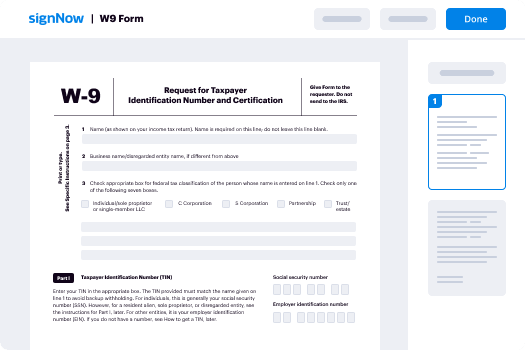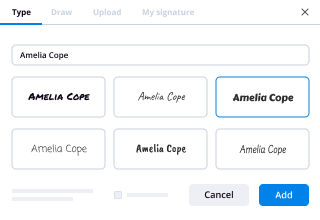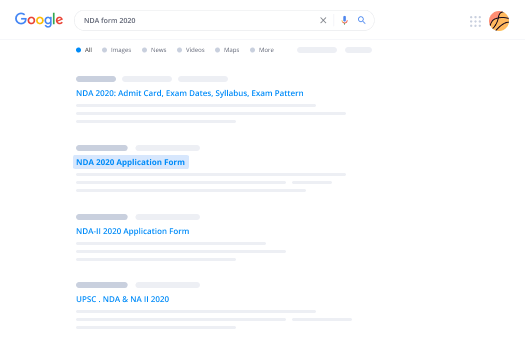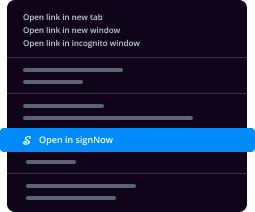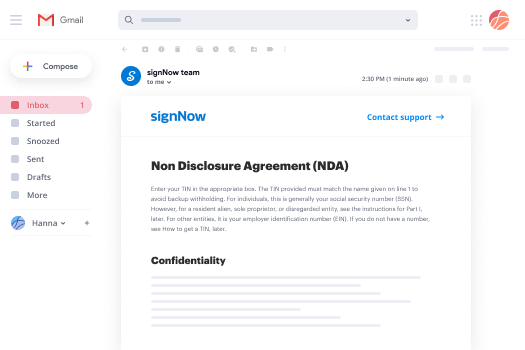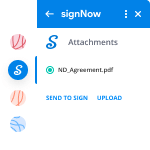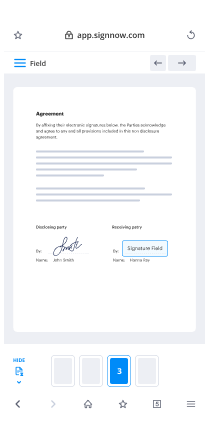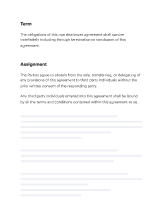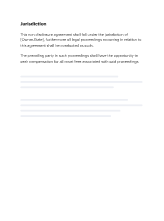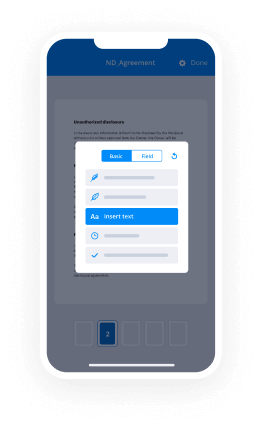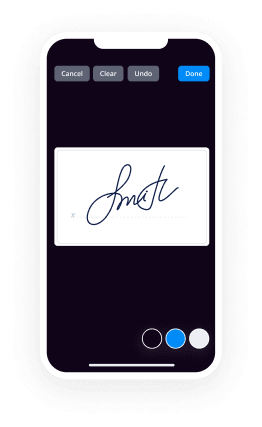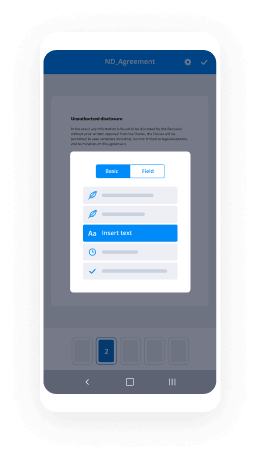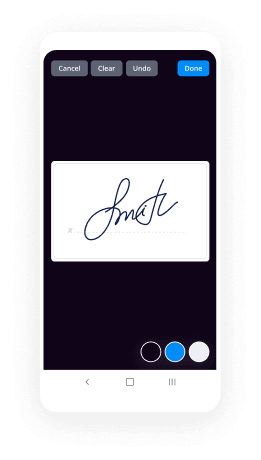Implementación De Firmas Electrónicas
- Rápido para iniciar
- Fácil de usar
- Soporte 24/7
Las empresas con visión de futuro de todo el mundo confían en SignNow






Tu guía completa de cómo hacerlo
Hoy en día, probablemente no encontrarás una empresa que no utilice tecnologías contemporáneas para automatizar el flujo de trabajo. La firma digital ya no es el futuro, sino el presente. Las empresas actuales que utilizan su facturación simplemente no pueden permitirse renunciar al software basado en la web que proporciona herramientas innovadoras de automatización de procesamiento de archivos, incluida la opción de implementar firmas electrónicas.
Cómo manejar la función de Implementar firmas electrónicas de airSlate SignNow:
-
Después de ingresar a nuestro sitio web, inicia sesión o registra tu perfil si no tienes uno, te tomará un par de segundos.
-
Subir el documento necesario o elegir uno de tus carpetas de biblioteca: Documentos, Archivo, Plantillas.
-
Debido a la compatibilidad de almacenamiento en la nube, puedes subir rápidamente el documento necesario desde las nubes recomendadas con prácticamente cualquier dispositivo.
-
Encontrarás tu archivo abierto en el Editor PDF avanzado donde puedes hacer modificaciones antes de continuar.
-
Escribe texto, coloca imágenes, añade anotaciones o campos rellenables para completar más adelante.
-
Utiliza el botón Mi Firma para firmar tú mismo o incluye Campos de Firma para enviar la solicitud de eFirma a uno o varios destinatarios.
-
Utiliza el botón HECHO cuando termines para continuar con la función de Implementar firmas electrónicas.
La solución en línea de airSlate SignNow es esencial para aumentar la efectividad y la producción de todos los procesos operativos. Implementar firmas electrónicas es una de las capacidades que ayudará. Usar la aplicación basada en la web hoy en día es en realidad una necesidad básica, no una ventaja competitiva. ¡Pruébalo ahora!
Cómo funciona
Califica tu experiencia
What are electronic signatures?
Electronic signatures, often referred to as eSignatures, are digital representations of consent or agreement. They allow individuals to sign documents electronically, eliminating the need for physical signatures on paper. This method is widely recognized and legally binding in the United States, thanks to the Electronic Signatures in Global and National Commerce (ESIGN) Act and the Uniform Electronic Transactions Act (UETA). Electronic signatures streamline the signing process, making it faster and more efficient for businesses and individuals alike.
How to use electronic signatures
Using electronic signatures involves a straightforward process that can be completed in just a few steps. First, upload the document you need signed to the airSlate SignNow platform. Next, specify the recipients who need to sign the document. You can then add signature fields and any other necessary information, such as dates or initials. Once everything is set, send the document for signature. The recipients will receive an email notification prompting them to review and sign the document electronically. After all signatures are collected, the completed document is securely stored and can be easily accessed.
Steps to complete electronic signatures
Completing electronic signatures is efficient and user-friendly. Follow these steps to ensure a smooth process:
- Upload your document: Start by selecting the file you wish to send for signature.
- Add recipients: Enter the email addresses of those who need to sign the document.
- Place signature fields: Drag and drop signature fields onto the document where signatures are required.
- Send for signature: Click the send button to initiate the signing process.
- Track progress: Monitor the status of the document to see who has signed and who still needs to.
- Receive the completed document: Once all parties have signed, you will receive the finalized document.
Legal use of electronic signatures
Electronic signatures are legally valid and enforceable in the United States under federal law. The ESIGN Act and UETA provide the framework for the legal acceptance of electronic signatures, ensuring they hold the same weight as traditional handwritten signatures. It is important for users to understand that for an electronic signature to be valid, it must be associated with a clear intent to sign, and the signer must have consented to use electronic signatures. Businesses should also ensure compliance with any industry-specific regulations that may apply.
Security & Compliance Guidelines
Ensuring the security and compliance of electronic signatures is crucial for protecting sensitive information. airSlate SignNow employs advanced encryption methods to safeguard documents during transmission and storage. Additionally, it is essential to maintain a clear audit trail, which records every action taken on the document, including when it was sent, viewed, and signed. Users should also verify the identity of signers through secure authentication methods, such as email verification or multi-factor authentication, to enhance security.
Documents You Can Sign
With electronic signatures, a wide variety of documents can be signed digitally. Common types include contracts, agreements, forms, and consent documents. Businesses often use electronic signatures for sales contracts, non-disclosure agreements, and employment forms. The versatility of electronic signatures allows for efficient processing of documents across various industries, making it easier to manage paperwork without the need for printing, scanning, or mailing.
¡Obtenga ahora firmas vinculantes desde el punto de vista jurídico!
-
Mejor ROI. Nuestros clientes logran un promedio de 7x ROI en los primeros seis meses.
-
Se adapta a sus casos de uso. De las PYMES al mercado medio, airSlate SignNow ofrece resultados para empresas de todos los tamaños.
-
Interfaz de usuario intuitiva y API. Firma y envía documentos desde tus aplicaciones en minutos.
Firma en línea FAQs
-
What are electronic signatures and how do they work?
Electronic signatures are digital representations of a person's intent to agree to the contents of a document. They work by allowing users to sign documents electronically, ensuring authenticity and security. With airSlate SignNow, you can easily create, send, and manage electronic signatures in a user-friendly interface. -
Are electronic signatures legally binding?
Yes, electronic signatures are legally binding in many countries, including the United States, under the ESIGN Act and UETA. airSlate SignNow complies with these regulations, ensuring that your electronic signatures hold the same legal weight as traditional handwritten signatures. This makes it a reliable choice for businesses looking to streamline their signing processes. -
What features does airSlate SignNow offer for electronic signatures?
airSlate SignNow offers a variety of features for electronic signatures, including customizable templates, real-time tracking, and secure storage. Users can also integrate with popular applications to enhance their workflow. These features make it easy to manage documents and ensure a seamless signing experience. -
How much does airSlate SignNow cost?
airSlate SignNow offers flexible pricing plans to accommodate different business needs. The cost varies based on the features and number of users, making it a cost-effective solution for electronic signatures. You can choose a plan that best fits your budget and requirements. -
Can I integrate airSlate SignNow with other applications?
Yes, airSlate SignNow supports integrations with various applications, including CRM systems, cloud storage services, and productivity tools. This allows you to streamline your workflow and manage electronic signatures alongside your existing tools. Integration enhances efficiency and simplifies document management. -
What are the benefits of using electronic signatures?
Using electronic signatures offers numerous benefits, including faster turnaround times, reduced paper usage, and improved security. With airSlate SignNow, you can expedite the signing process and enhance collaboration among team members. This not only saves time but also contributes to a more sustainable business model. -
Is airSlate SignNow secure for electronic signatures?
Absolutely! airSlate SignNow prioritizes security with advanced encryption and compliance with industry standards. Your electronic signatures and documents are protected, ensuring that sensitive information remains confidential. This commitment to security makes it a trusted choice for businesses.
Tu guía completa de cómo hacerlo
Solución confiable de eSignature
Únase a más de 28 millones de usuarios de airSlate SignNow
Obtener más
- Explora las características populares de eFirma: ...
- Explora las características populares de eFirma: ...
- Explora las características populares de eSignature: ...
- Comienza con eSignature: solución de firma
- Explora las características populares de eSignature: ...
- Comienza con eSignature: sistema de firma
- Comienza con eSignature: herramientas de firma
- Comienza con eSignature: tutorial de firma




















